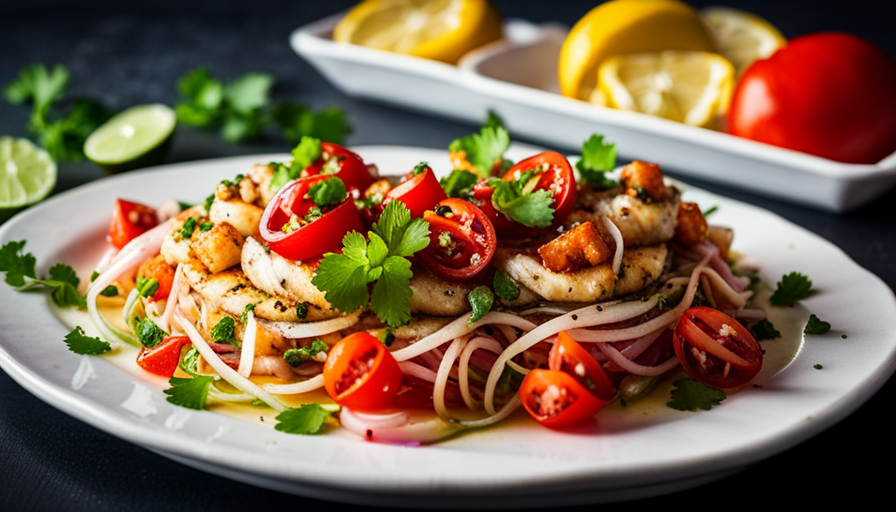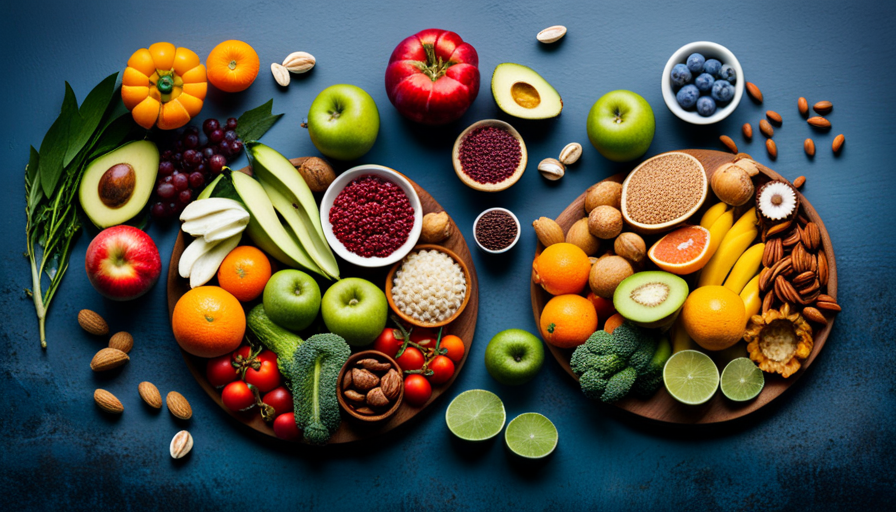Have you ever felt the delight of sinking your teeth into a crisp, juicy apple and experiencing a explosion of flavors dance on your tongue? That moment of pure bliss is exactly what enthusiasts of raw food, like myself, strive for with every meal. Firmly believing in the benefits of natural produce, I have embraced a raw food lifestyle, promoting the consumption of foods that are raw, unprocessed, and organic.
But what exactly classifies as raw food? In this article, we will explore the various categories of raw foods, including fruits and vegetables, nuts and seeds, grains, and even dairy products. We will delve into the preparation techniques that preserve the nutritional integrity of these foods, as well as discuss the safety measures to follow when consuming raw food.
Whether you’re curious about transitioning to a raw food diet or simply interested in understanding the principles behind it, this article will provide you with an informative and evidence-based exploration of the raw food lifestyle.
So, let’s embark on this journey together and discover the wonders of raw food!
Key Takeaways
- Raw food refers to unprocessed, uncooked, and organic foods consumed in their natural state.
- Raw food is not cooked, processed, or heated above 118 degrees Fahrenheit (48 degrees Celsius).
- Raw food is rich in essential nutrients, vitamins, minerals, and enzymes.
- Raw food diets may aid in weight management and promote digestive health.
Definition of Raw Food
So, what exactly qualifies as raw food? Raw food refers to any food that is consumed in its natural state, without undergoing any form of cooking, processing, or heating above 118 degrees Fahrenheit (48 degrees Celsius). This includes fruits, vegetables, nuts, seeds, and certain dairy products like raw milk and cheese.
Raw food enthusiasts argue that consuming raw food provides numerous benefits. Firstly, raw food is rich in essential nutrients, such as vitamins, minerals, and enzymes, which can be destroyed or reduced during cooking. Additionally, raw food is often lower in calories and higher in fiber, which can aid in weight management and promote digestive health. Some studies suggest that raw food diets may also lower the risk of chronic diseases like heart disease and certain cancers.
However, it is important to note that there are potential risks associated with consuming raw food. Raw food may contain harmful bacteria and parasites, which can cause foodborne illnesses. It’s crucial to handle and prepare raw food properly to minimize these risks.
Moving on to fruits and vegetables, these are key components of a raw food diet. They’re packed with vitamins, minerals, antioxidants, and phytochemicals that are beneficial for overall health.
Fruits and Vegetables
Crisp and vibrant, fruits and vegetables burst with natural goodness. They’re not only delicious, but also packed with essential vitamins, minerals, and fiber. Incorporating more raw fruits and vegetables into your diet can have numerous benefits for your health.
Here are five reasons why you should consider adding more of them to your daily meals:
-
Nutrient-rich: Raw fruits and vegetables are a great source of vitamins and minerals that are essential for overall well-being. They provide antioxidants that help protect your body against harmful free radicals.
-
Digestive health: The high fiber content in raw fruits and vegetables promotes healthy digestion and prevents constipation. They also contain enzymes that aid in the digestion process.
-
Weight management: Raw fruits and vegetables are low in calories and high in water content, making them a perfect option for weight management. They provide a feeling of fullness, reducing the chances of overeating.
-
Immune system support: Eating raw fruits and vegetables can strengthen your immune system due to their high content of vitamin C and other immune-boosting nutrients.
-
Heart health: Studies have shown that a diet rich in raw fruits and vegetables can lower the risk of heart disease by reducing blood pressure and cholesterol levels.
To incorporate more raw fruits and vegetables into your diet, try starting your day with a fruit smoothie or adding a side salad to your meals. Remember to wash them thoroughly and eat them fresh to maximize their nutritional benefits.
As we move on to the next section about nuts and seeds, you’ll discover their amazing health benefits as well.
Nuts and Seeds
Packed with essential nutrients, nuts and seeds are a delicious and convenient way to boost your overall health. These small powerhouses aren’t just rich in healthy fats, fiber, and protein, but they also provide a wide range of vitamins, minerals, and antioxidants.
From almonds and walnuts to chia seeds and flaxseeds, each type of nut and seed offers its own unique nutritional benefits.
Nuts and seeds are known for their heart-healthy properties. Studies have shown that incorporating them into your diet can help lower cholesterol levels and reduce the risk of heart disease. Additionally, they’re a great source of plant-based protein, making them an excellent choice for vegetarians and vegans.
In the culinary world, nuts and seeds have endless possibilities. They can be enjoyed on their own as a quick and nutritious snack, or added to salads, smoothies, and baked goods for an extra crunch. You can even make your own homemade nut butter or seed-based dressing for a flavorful twist.
As we move on to the next section about grains, it’s important to note that incorporating a variety of nuts, seeds, fruits, and vegetables into your diet is key to maintaining a balanced and nutritious eating plan.
Grains
Grains are an essential part of a healthy diet, providing a versatile and delicious foundation for countless meals and snacks. They’re a great source of carbohydrates, fiber, and essential nutrients like B vitamins and minerals.
When it comes to raw food, there’s some debate about whether grains can be considered raw. While most grains are typically cooked before consumption, there’s an alternative method called sprouting that allows grains to be eaten in their raw form. Sprouting involves soaking the grains in water until they begin to germinate. This process activates enzymes and increases the nutrient content of the grains.
Sprouted grains are easier to digest and may have higher levels of certain vitamins and minerals compared to their cooked counterparts. They can be used in various dishes like salads, raw bread, and raw granola. Incorporating sprouted grains into a raw food diet adds variety and texture to meals. However, it’s important to note that not all grains are suitable for sprouting. Some grains, like wheat, are more commonly sprouted, while others, like rice, are typically cooked. It’s always best to research and follow proper sprouting techniques to ensure food safety.
Moving on to the next section about dairy products, it’s important to understand the role they play in a raw food diet.
Dairy Products
When it comes to dairy products, two key points that I’d like to discuss are raw milk and its benefits, as well as the options for raw cheese and yogurt.
Raw milk is milk that hasn’t been pasteurized or homogenized, and it’s believed to retain more nutrients and enzymes compared to processed milk.
Raw cheese and yogurt are made from raw milk and can offer a range of flavors and textures that are different from their pasteurized counterparts.
These options provide an opportunity to explore different tastes and potential health benefits.
Raw Milk and Its Benefits
If you’re looking to enhance your diet with a natural and nutrient-rich beverage, consider giving raw milk a try. Raw milk is milk that hasn’t been pasteurized or homogenized, meaning it’s in its natural state.
Many people choose raw milk as an alternative to conventional milk because they believe it contains more beneficial nutrients and enzymes. However, it’s important to note that raw milk also comes with some controversy. Critics argue that raw milk can contain harmful bacteria that can cause foodborne illnesses.
Despite this controversy, some studies suggest that raw milk may have certain health benefits, such as a higher content of vitamins and minerals.
If you’re interested in exploring raw milk options, it’s also worth considering raw cheese and yogurt, which are made from raw milk and offer their own unique benefits.
Raw Cheese and Yogurt Options
Consider trying out different varieties of raw cheese and yogurt made from unpasteurized milk, as they offer a unique and flavorful addition to your diet.
Raw cheese, like raw milk, contains beneficial bacteria and enzymes that can aid in digestion and improve gut health. It’s also rich in vitamins and minerals such as calcium, phosphorus, and vitamin A. Additionally, raw cheese is often made using traditional methods, preserving the natural flavors and textures of the milk.
As for yogurt, making your own homemade yogurt from raw milk allows you to control the ingredients and fermentation process, ensuring a high-quality product. Homemade yogurt can be a great source of probiotics, protein, and calcium.
These raw cheese and yogurt options provide a nutritious and delicious alternative to their pasteurized counterparts.
Moving on to the next section, let’s explore the benefits of raw food diets.
Raw Food Diets
Indulge in the vibrant world of raw food diets, where your plate becomes a canvas of crisp greens, juicy fruits, and nourishing nuts and seeds. Raw food diets have gained popularity in recent years due to their numerous health benefits. By consuming uncooked, unprocessed foods, you can maximize the nutritional value of your meals.
Raw foods are rich in enzymes, vitamins, minerals, and antioxidants, which can support digestion, boost immunity, and improve overall well-being. One of the advantages of a raw food diet is the abundance of raw food recipes available. From refreshing salads and smoothies to inventive raw desserts, there are endless possibilities to explore. You can experiment with different combinations of fruits, vegetables, and nuts to create delicious and nourishing meals that’ll satisfy your taste buds and provide your body with essential nutrients.
Transitioning into the next section about raw food preparation techniques, it’s important to understand that raw food diets require specific methods to ensure food safety and enhance flavor. By utilizing techniques such as soaking, sprouting, and dehydrating, you can unlock the full potential of raw ingredients, making them easier to digest and enhancing their natural flavors.
So, let’s dive into the world of raw food preparation techniques and discover how to unleash the true essence of these vibrant and nutritious foods.
Raw Food Preparation Techniques
Let’s dive into the exciting world of preparing raw ingredients and discover how to unlock their full potential for maximum flavor and nutrition.
When it comes to raw food preparation techniques, there are countless options to explore. One of the key benefits of raw food is that it retains its natural enzymes and nutrients, which can be lost through cooking. By using techniques like soaking, sprouting, and fermenting, we can enhance the nutritional value of raw ingredients even further.
Soaking is a simple yet effective technique that involves immersing ingredients like nuts, seeds, and grains in water for a certain period of time. This process not only softens the texture but also helps to remove any anti-nutrients, making the ingredients more digestible and increasing their nutrient availability.
Sprouting, on the other hand, involves germinating seeds and legumes to increase their nutrient content and improve digestibility.
When it comes to raw food recipes, the possibilities are endless. From refreshing salads and smoothies to delicious raw desserts, there is something for everyone. Raw food recipes often showcase the natural flavors and textures of ingredients, allowing them to shine in their purest form.
As we delve into the world of raw food safety, it’s important to ensure that we handle raw ingredients properly to prevent foodborne illnesses.
Raw Food Safety
Ensuring the safety of our culinary creations is of utmost importance, as we navigate the realm of uncooked ingredients. When it comes to raw food, nutrition is one of the key factors to consider. Raw foods retain their natural enzymes and nutrients, which can be beneficial for our overall health. However, there are potential risks associated with consuming raw food as well.
To evoke emotion in the audience, let’s delve into two sub-lists:
-
The benefits of raw food:
- Improved digestion: Raw foods are rich in fiber, aiding in digestion and promoting a healthy gut.
- Enhanced nutrient absorption: Raw foods are packed with essential vitamins and minerals that are easily absorbed by our bodies.
-
The potential risks of raw food:
- Bacterial contamination: Raw foods may contain harmful bacteria like Salmonella or E. coli, which can cause foodborne illnesses.
- Nutrient deficiencies: While raw foods are nutritious, some nutrients are better absorbed when cooked, such as lycopene in tomatoes.
Transitioning to a raw food diet requires careful consideration of these potential risks and benefits. By understanding the importance of food safety and being aware of the potential risks, we can make informed decisions about our culinary journey.
Transitioning to a Raw Food Diet
Embarking on a journey towards a raw food diet can be a transformative experience for our bodies and minds. When transitioning to a raw food diet, it’s important to start slow and gradually increase the amount of raw foods in your meals. This allows your body to adjust and prevents any potential digestive challenges.
Incorporating more fruits, vegetables, nuts, and seeds into your meals is a great way to start. These foods are packed with nutrients and enzymes that are beneficial to our health.
One of the potential challenges of transitioning to a raw food diet is the need for meal planning and preparation. Raw food meals often require more time and effort in the kitchen, as they involve soaking, sprouting, and blending. However, with proper planning and organization, this challenge can be overcome. Preparing meals in advance and having a variety of raw food recipes on hand can make the transition smoother.
Embracing the raw food lifestyle can have numerous benefits for our health. By gradually incorporating more raw foods into our diet and overcoming the potential challenges, we can experience increased energy, improved digestion, and a greater sense of well-being.
So, let’s dive into the world of raw food and discover the amazing benefits it has to offer.
Conclusion: Embracing the Raw Food Lifestyle
Incorporating a raw food lifestyle into my daily routine is like unlocking a vibrant garden of health and vitality, where each bite nourishes my body and rejuvenates my spirit. Not only does this lifestyle provide numerous health benefits, but it also positively impacts my emotional well-being.
One of the key benefits of embracing a raw food lifestyle is the improvement in my emotional well-being. Raw foods are packed with essential nutrients, enzymes, and antioxidants that support brain health and help balance mood. By consuming a diet rich in fruits, vegetables, nuts, and seeds, I experience increased energy levels and mental clarity, which in turn enhances my overall emotional state. I feel more positive, focused, and in control of my emotions.
Moreover, the health benefits of a raw food lifestyle are undeniable. Raw foods are naturally low in calories and high in fiber, which aids in weight management and digestion. Additionally, the abundance of vitamins, minerals, and phytonutrients found in raw foods strengthens my immune system and protects against chronic diseases. I have noticed a significant improvement in my skin health, as well as a reduction in inflammation and joint pain.
Embracing a raw food lifestyle not only improves my physical health but also has a profound impact on my emotional well-being. The nourishing qualities of raw foods provide me with the energy and vitality I need to thrive each day. By choosing to incorporate more raw foods into my diet, I’m taking a proactive step towards a healthier, happier life.
Frequently Asked Questions
Can raw food be cooked at any temperature?
Raw food can be cooked, but it’s important to note that cooking at high temperatures can destroy some of the nutrients and enzymes in the food.
However, there are ways to cook raw food while still preserving its nutritional value. For example, steaming, blanching, or using a dehydrator at low temperatures can help retain nutrients.
Ultimately, the benefits of a raw food diet for overall health and well-being come from consuming foods in their natural state, as they’re rich in vitamins, minerals, and enzymes.
Are frozen fruits and vegetables considered raw?
Frozen fruits and vegetables are not considered raw. While freezing preserves some nutrients, the freezing process alters the texture and can cause a loss in certain vitamins and enzymes. However, they still provide nutritional benefits like vitamins, minerals, and fiber.
It is important to note that consuming raw food, including frozen produce, carries potential safety concerns due to the risk of foodborne illnesses. Proper washing and handling techniques are crucial to minimize these risks.
Can roasted nuts and seeds still be considered raw?
Roasted nuts and seeds cannot be considered raw because they’ve undergone a cooking process. Raw food refers to unprocessed or minimally processed foods that haven’t been heated above a certain temperature. The key difference between raw and processed foods lies in their nutritional content.
Raw nuts and seeds retain their natural enzymes, vitamins, and minerals, which can provide numerous health benefits. These benefits include improved digestion, increased energy, and enhanced nutrient absorption.
Are fermented grains considered raw?
Fermented grains are not considered raw because the fermentation process involves the use of beneficial bacteria or yeast that break down the carbohydrates in the grains. This process enhances the nutritional benefits of the grains by increasing their digestibility and nutrient availability.
To ferment grains at home, you can soak them in water and an acidic medium like lemon juice or apple cider vinegar for a certain period of time. This promotes the growth of beneficial bacteria and initiates the fermentation process.
Is raw milk considered a raw dairy product?
Raw milk is considered a raw dairy product. It has numerous nutritional benefits, as it contains vitamins, minerals, and beneficial enzymes that are destroyed during pasteurization.
Raw milk is also a good source of protein and healthy fats. However, it is important to note that consuming raw dairy products comes with safety concerns. Raw milk can harbor harmful bacteria, such as Salmonella and E. coli, which can cause foodborne illnesses.
Therefore, it’s crucial to handle and store raw milk properly to reduce the risk of contamination.
Are the Foods Eaten Raw in Japan Considered Raw Food in General?
In Japanese raw food culture, the focus is on fresh, uncooked ingredients like sashimi, sushi, and salads. While many Japanese dishes are consumed raw, the definition of raw food in general encompasses a broader range of unprocessed and uncooked foods beyond those typically found in traditional Japanese cuisine.
Conclusion
In conclusion, after exploring the world of raw food, I’ve come to appreciate the power of this lifestyle. By embracing the raw food lifestyle, you can experience a range of benefits, from increased energy levels to improved digestion.
However, it’s important to remember that transitioning to a raw food diet requires careful planning and consideration. While the idea of consuming uncooked food may seem daunting, the delicious array of fruits, vegetables, nuts, and seeds available make it a truly tantalizing experience.
So why not give it a try and unlock a new level of health and vitality?










